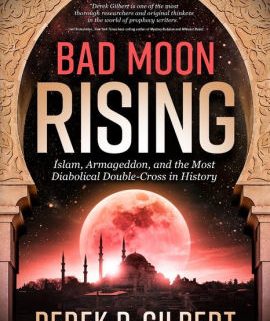The pagan gods of the ancient world did not humbly submit after the Resurrection of Jesus Christ. Instead, they’ve continued in their rebellion. Maybe they figure they’ve got nothing to lose. Like Inanna in the Epic of Gilgamesh, who tried to destroy Uruk because she’d been rejected by the hero of the tale, they’re willing to destroy everything rather than let the Messiah return to establish His throne over a world restored to its intended glory.
But they’re also arrogant enough to think they can win. The entities conspiring against God are playing multidimensional chess. We humans are playing checkers, so I won’t pretend to have all of the answers. This book will only cover one of the most significant aspects of the rebellion, a front opened by the small-g gods after they realized they’d been outplayed.
Their first response to the Resurrection was to inspire the Roman government and Jewish religious authorities to try to crush the growing body of believers. By the fourth century AD, when it was clear that Christianity was not going away, the Fallen tried a different tactic. The empire of the storm-god first legalized the faith with Constantine’s Edict of Milan in AD 313. Then in 380, Christianity became the official state religion when Theodosius issued the Edict of Thessalonica. Once the Church became a path to wealth and political power, there was no shortage of men and women who chose the clergy as a career—but it wasn’t because they were interested in saving sinners from the fires of hell.
Making Christianity the official religion of the Roman Empire was a brilliant move. Corruption in the Church persists to this day and it infects all denominations. But that has only weakened the body of believers, not killed it; as of this writing, the followers of Jesus Christ still outnumber all other religions on the earth.
But the Enemy employed another stratagem, one that’s exploited the Church’s weakness and the dilution of the gospel since the Renaissance and Enlightenment. Let’s begin by tracking the activity of the pagan gods in the years after the Resurrection.
Looking at the ebb and flow of history from high above the page, as it were, we can sometimes see patterns that are hidden when we zoom in too close, sort of like trying to make out an image in an old newspaper by looking at it under a microscope. All we see are blobs of ink—the pixels, to use a more modern reference. The picture only comes into focus when you look at it from farther away.
In the same way, trying to see into the spirit realm is a good way to drive yourself crazy. We aren’t designed to do that, and God has warned us not to try. But we can make out some of the shapes and patterns, the actions of the principalities and powers, if we step back and look at how history has progressed through the ages.
A rough outline of the spiritual history of the ancient Near East shows that there were at least two transfers of power in the pantheon. First, a primordial god of heaven was overthrown by his son, who was considered “the” god between about 3000 and 2000 BC.
Around the time that the Amorites emerged as the dominant people group in the Near East, “the” god was replaced as king of the pantheon by the storm-god—except in Akkad and Sumer, where the city-god of Babylon, Marduk, occupied that place of honor.
However, the personal god of the founding dynasty of Babylon was the moon-god. As we noted earlier, some scholars now believe that the Sumerian god Amurru was actually an epithet of the lunar deity, “god of the Amurru (Amorite) land.” A text only translated within the last ten years reveals that the moon-god, Sîn, was believed to preside over the Mesopotamian divine council at least some of the time.
The nations led by these various deities fought with one another throughout the period of history covered by the Bible. Beginning around 1800 BC, the time of Abraham and Isaac, Marduk and his followers ruled Babylonia and Sumer, while Baal worshipers dominated western Mesopotamia (Canaan), followers of the sun-god controlled most of Egypt, and the moon-god was the chief deity of the nomadic tribes of the steppe and deserts of Syria and Arabia.
The fall of the Neo-Babylonian Empire to the Medes and Persians in 539 BC was probably another rebuke of the moon-god by Yahweh, who revealed to the prophet Isaiah, about a hundred and fifty years earlier, His plan to use Cyrus to return the Jewish exiles to Jerusalem.
Oddly, if scholars are correct about the Persian god Ahura Mazda, this replaced one empire subject to Marduk with another that worshiped the same god under a different name.
So, was Marduk/Ahura Mazda the “prince of Persia” who fought against the angelic messenger who came to the prophet Daniel? It’s impossible to know, and wondering about the prince’s identity leads to other questions we can’t answer. For example, did the prince of Persia resist the angel because he didn’t want Cyrus to free the Jews of Babylon?
These questions can only be answered with speculation. It’s curious that Marduk doesn’t fit the pattern of succession among the gods. Across the ancient Near East, and even as far away as Scandinavia and India, the storm-god rose to the top of the pantheon, but at Babylon, a city-god about whom we know nothing prior to that city’s rise to power, claimed the throne of the gods. We can only ask, “Why?”
Is it possible that the rise of the Zoroastrian religion in Persia, which emerged just before the Medes and Persians conquered the lands of the Bible as far west as Greece, was part of a civil war among the rebel angels? Given that the moon-god, Sîn/Yarikh, was the patron deity of the founders of Babylon (and of most Amorites in the days of Abraham), then maybe Marduk was a figurehead who was head of the infernal council in name only. There isn’t a single event in the Bible that appears to be specifically directed at Marduk, except maybe the reference to the size of Og’s bed.
Continuing with our speculation, the rise of the Persian Empire and its devotion to Ahura Mazda, possibly another aspect of Marduk, may have been that entity’s play to go solo by rebelling against the rebels. Of course, God used it for His purposes, to free His people from Babylon and humble the moon-god (Belshazzar’s feast was held for the fall akitu festival for Sîn).
But Marduk’s shot at glory didn’t last long; within two centuries, people of the storm-god, first Greek and then Roman, pushed the Persian Empire back to Mesopotamia. And with the rise of Islam in the seventh century AD, Zoroastrianism faded into the background. Today, it’s estimated that there are fewer than three million Zoroastrians in the world; in the 1990s, the Guiness Book of World Records began labeling Zoroastrianism as the “major religion nearest extinction.”
There are hints in pagan texts of other rifts between the Fallen. Two letters to the king of Mari from the ambassador of Yamkhad, a powerful kingdom based at Aleppo, mention the delivery of the clubs used by the storm-god “with which the deity boasts to have struck his enemy, the sea” to the temple of “the” god, Dagan, in the city of Terqa.
Scholars don’t know exactly what the letters mean, but there are two probable messages: First, they implied that Mari was subordinate to Yamkhad, just as Dagan (El, Enlil, etc.) had been replaced at the top of the pantheon by the storm-god, Adad (Baal). Second, in a backhanded way, it claims a victory for Adad/Baal that had been credited to Marduk.
Thus says Adad.… I brought you back to the throne of your father, I brought you back. The weapons with which I fought the Sea [Têmtum] I gave to you. With the oil of my bitter victory I anointed you, and no one before you could stand. My one word hear!
Têmtum is the Akkadian word for Tiamat, the chaos dragon defeated by Marduk in the Enuma Elish. Now, this may be political posturing, sort of like saying, “Our gods are better than your gods, nyaah nyaah nyaah,” but it may have been inspired in the spirit realm as members of the infernal council plotted and schemed against one another.
Another example of this comes from the western Amorite kingdom of Ugarit in a myth about a drunken feast at the house of the creator-god El.
Yarikh [the moon-god] arched his back like a d[o]g;
he gathered up crumbs beneath the tables.
(Any) god who recognized him
threw him meat from the joint.
But (any god) who did not recognize him
hit him with a stick beneath the table.
At the call of Athtart [Astarte/Ishtar] and Anat [the Canaanite war-goddess] he approached.
Athtart threw him a haunch,
and Anat a shoulder of meat.
The porter of El’s house shouted:
“Look!
Why have you thrown a haunch to the dog,
(why) to the cur have you thrown a shoulder?”
This is a great example of a text that drives scholars crazy. The meaning is unclear; it could refer to ritual drinking to reach an altered state of consciousness, or it could simply be a long and convoluted cure for a hangover. Either way, the moon-god, bearing his Amorite name, Yarikh, is depicted as a dog, and canines were not man’s best friend in the ancient Near East. This text comes from the final years of Ugarit in the thirteenth century BC. That was the time of the judges in Israel, after the conquest—in other words, after the moon-god had been humiliated at the Wilderness of Sîn, Mount Sinai, Jericho, and the Valley of Aijalon.
Does this text reflect a demotion in the infernal council? The moon-god was at or near the top of the pantheon in Mesopotamia until Joshua led the Israelites across the Jordan. After the Long Day, the moon-god faded into the background until his devotee Nabonidus took the crown of Babylon nearly a thousand years later.
Then the Medes and Persians destroyed Babylon as an independent kingdom, and a couple of centuries later, the Greeks and Romans came. Quick, now: How many myths about the Greco-Roman moon-goddess, Selene/Luna, do you know? Probably not many, if any. In the pantheon of Greece and Rome, the moon-deity was strictly supporting cast, a back-bencher.
Again, this is speculation, an attempt to discern the history of the unseen realm from evidence in the natural. We have limited ability to see into the spirit world, but it fits recorded history. Before Christ, the Fallen fought amongst themselves as well as with God. After the Resurrection, it appears that they put aside some of their mutual distrust.
We’ll explore that in more depth in future columns.
From Bad Moon Rising: Islam, Armageddon, and the Most Diabolical Double-cross in
History by Derek P. Gilbert

Derek Gilbert Bio
Derek P. Gilbert hosts SkyWatchTV, a Christian television program that airs on several national networks, the long-running interview podcast A View from the Bunker, and co-hosts SciFriday, a weekly television program that analyzes science news with his wife, author Sharon K. Gilbert.
Before joining SkyWatchTV in 2015, his secular broadcasting career spanned more than 25 years with stops at radio stations in Philadelphia, Saint Louis, Little Rock, and suburban Chicago.
Derek is a Christian, a husband and a father. He’s been a regular speaker at Bible prophecy conferences in recent years. Derek’s most recent book is The Great Inception: Satan’s PSYOPs from Eden to Armageddon. He has also published the novels The God Conspiracy and Iron Dragons, and he’s a contributing author to the nonfiction anthologies God’s Ghostbusters, Blood on the Altar, I Predict: What 12 Global Experts Believe You Will See by 2025, and When Once We Were a Nation.





Leave a Reply
Want to join the discussion?Feel free to contribute!